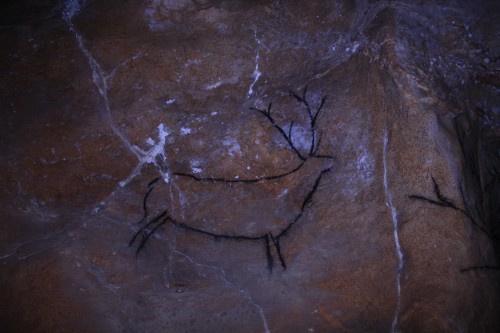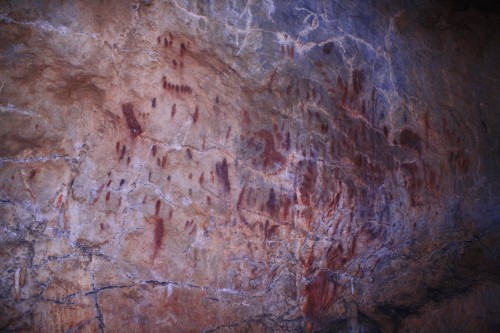Dr Bruno Fazenda, an Acoustics colleague at University of Salford, has just published a fascinating paper on cave ‘art’ and acoustics. I asked him about the significance of what he found, and he wrote me this guest blog.
Previous research in the fields of acoustics and archaeology has suggested that cave ‘art’ from Paleolithic times was placed where there was a particular acoustic response. According to the opinion of some researchers, this was evidence that our ancestors were somehow choosing the places where to paint [1] by listening to the acoustic responses of the caves and choosing particular places where they might have found echoes, long reverberations and resonances.
A paper (Fazenda et al., 2017) of mine has just been published showing a correlation between the location of cave parietal art and acoustic response. This research, using state of the art methods and technology, set out to find better evidence to support or dismiss the earlier claims. Although we found a statistical correlation between the location of paintings and the acoustic response, it would be wrong to interpret what we found as unambiguous evidence that the paintings were deliberately placed where there is resonance or distinct reverberation.

Background and previous work
Numerous caves in Western Europe hold evidence of cultural and artistic activity, in the form of sculptures, paintings and engravings, henceforth called motifs, created by our Upper Palaeolithic ancestors (Clottes et al., 1995; Conard et al., 2009; Morley, 2013). These are known as the famous Caves of Altamira in Spain and Lascaux in France. Archaeological dating places this activity at around 40000 to 15000 years ago and there is much discussion about their meaning, but it is clear that around this area and at this time there was an important cultural and artistical development, some of which is claimed to be associated with an appreciation of sound and early forms of musical expression (Megaw, 1968; Scarre and Lawson, 2006).
In the late 80s, early 90s, a few scientists suggested that the motifs found in these caves (as well as some open air sites) might have been placed where they are because of the acoustic response at those specific positions. Reznikoff and Dauvois suggest resonances and echoes as a means of navigating and finding the location of motifs within a number of caves in Southern France (Reznikoff and Dauvois, 1988), whilst Waller (1993) suggests that paintings of specific animals, such as horses, might be found where there is evidence of echoes which replicate the sound of their hooves when galloping. There are critical methodological issues with these previous studies. For example, Reznikoff’s analysis of the acoustics of the caves he visited were performed with his own vocalisations and measured with sound level meters and wrist watches. Waller presents a brief statistical analysis that shows significant differences in echo levels between locations with different types of motifs (Waller, 1993a) but there is no detail on what is the acoustic definition of ‘echo’ used or how it was measured and what are the statistical methods applied in the analysis. No-one evaluating acoustics for speech and music nowadays would use these processes and metrics. Acoustic science has developed a set of robust measures correlated with human response, including ones that are in international standards (ISO3382). There’s also much easier access to technology which affords a much more robust and systematic measurement of the acoustic response at numerous locations within a site.
Much of the research activity in archaeoacoustics nowadays seems to focus on finding correlations between sites of archaeological importance where material culture may be found, and the acoustic response at those sites. Typically, it is claimed that the existence of an acoustic effect (something like a resonance, echo, long reverberation or other ‘strange’ acoustic response) at a specific site or close to ancient material cultural, could be evidence that our ancestors acted in accordance with the acoustic response. This is obviously a very difficult claim to sustain and I make the argument in a study of the acoustics of Stonehenge (Fazenda, 2013, a, b) that a more complex interaction, beyond a direct acoustic intentionality, is likely to exist. Indeed, studies of a single site where a few motifs exist, often report evidence of acoustic intentionality. However, these studies commonly fail to include measurements at sites without any material culture to serve as a comparison or control. An unequivocal result must be corroborated by more than a few examples, preferably with robust statistical analysis showing significant results.
Our Recent Investigation
In 2012, a team with combined expertise in archaeology, musicology, musical archaeology and acoustics set off to try to gather systematic evidence of an association between the location and type of paintings in caves and the acoustic response measured within them (Fazenda et al., 2017). We measured 100s of locations at five caves which are part of the Cave of Altamira and Paleolithic Cave Art of Northern Spain World Heritage Site. Using the scientific method we hypothesised that acoustic response could explain the position, type and date of paintings in these caves.

Based on 100s of measurements taken at positions with and without motifs, we didn’t find supporting evidence that it explains type or date. However, we did find some statistical evidence, albeit weak, that there is a correlation between acoustic response and the position of paintings. For example, we found that the oldest type of paintings, which represent simple coloured dots or lines (see picture), are more likely to be found in places where there might be audible resonances. This was one of Reznikoff’s claims. We also found that if we were to group all of the motifs, regardless of their type, age or colour, they would most likely be found in places with moderate reverberation, neither too high or too low. This is the opposite of another of Reznikoff’s claims. And even though in many of these caves the density of material culture was so high that it was difficult to choose locations for control measurements, we never found any places within the caves where there were clear, audible echoes.
Painting by resonance?
A statistical correlation does not imply causation and what we need to consider is what could explain the correlation. Consider a modern example, all bathrooms have resonances and some reverberation which make them ideal places for singing in the shower. But what leads to their particular acoustic response is the extensive tiling and small size rather than a deliberate design to make them the common person’s auditorium. Post-apocalyptic societies might in the future discover our cities and find a “special place in every home where the acoustics were particular striking and supportive of archaic forms of emotional expression” where in fact they were coming across an elegant solution for a basic human need in a sanitized society.
The proposed explanation for the ancient art, is that our ancestors were somehow choosing the place for these motifs by listening to the response of the cave, showing a special appreciation of sound behaviour. But there might be other explanations that would also fit this correlation. For example, it might be that they were placing the motifs in such places because they felt safer in smaller, inaccessible spaces rather than large exposed galleries. Humans can easily detect the general size of a space, large or small, from the acoustic response. In a niche, they are more likely to feel safer and less exposed whilst they ‘perform their art’. Another line may be that such small niches are harder to access and therefore their activity would be more secret and harder to find – a kind of a reward for having managed to find such special place. A typical ‘Bruno has been here ‘ statement. Both these scenarios would lead to a correlation between the position of motifs and places exhibiting moderate reverberation and resonances, since this is the typical response of small, enclosed spaces.
We must not forget that all these explanations are still mere speculation, no more than the ‘appreciation of sound’ hypothesis offered by previous researchers, but that could explain the finding of such correlation.
What this all means is that we cannot dismiss the ‘appreciation of sound’ theory. But in order to prove it unequivocally we need more studies to corroborate this one, perhaps with larger statistical significance. Given that our results also show a significant effect of distance from the entrance to the motifs, I would argue that other aspects, such as rock porosity, location within the cave and other factors will be revealed as relatively more important factors than just the acoustic response.
References
Clottes, J., Chauvet, J. M., Brunel-Deschamps, E., Hillaire, C., Daugas, J. P., Arnold, M., Cachier, H., E vin, J., Fortin, P., Oberlin, C., Tisn erat, N., and Valladas, H. (1995). “Les peintures pal eolithiques de la grotte Chauvet-Pont d’Arc, a Vallon-Pont-d’Arc (Arde`che, France): Datations directes et indirectes par la m ethode du radiocarbon” (“Paleolithic paint- ings in the Chauvet-Pont d’Arc cave at Vallon-Pont-d’Arc (Arde`che, France): Direct and indirect dating by the radiocarbon method”), Cr. Acad. Sci. 320, 1133–1140.
Conard, N. J., Malina, M., and Munzel, S. C. (2009). “New flutes document the earliest musical tradition in southwestern Germany,” Nature 460, 737–740.
Fazenda, B. and Drumm, I., 2013a. Recreating the sound of Stonehenge. Acta Acustica united with Acustica, 99(1), pp.110-117.
Fazenda, B., Scarre, C., Till, R., Jiménez Pasalodos, R., Rojo Guerra, M., Tejedor, C., Ontañón Peredo, R., Watson, A., Wyatt, S., García Benito, C. and Drinkall, H., 2017. Cave acoustics in prehistory: exploring the association of Palaeolithic visual motifs and acoustic response. Journal of the Acoustical Society of America. 143 (3) pp 1332-1349
Fazenda, B.M., 2013b. The acoustics of Stonehenge. Acoustics Bulletin,38(1), pp.32-37.
Megaw, V. (1968). “Problems and non-problems in Palaeo-organology,” in Studies in Ancient Europe: Essays presented to Stuart Piggott, edited by J. M. Coles and D. D. A. Simpson (LUP, Leicester), pp. 333–358.
Morley, I. (2013). The Prehistory of Music: Human Evolution, Archaeology, and the Origins of Musicality (Oxford University Press, Oxford).
Reznikoff, I., and Dauvois, M. (1988). “The sound dimension of painted caves (original in French),” B. Soc. Prehist. Fr. 85(8), 238–246.
Scarre, C., and Lawson, G. (eds.) (2006). Archaeoacoustics (McDonald Institute Monographs, Cambridge).
Waller, S. J. (1993). “Sound and rock art,” Nature 363, 501.
Notes
[1] I use paint and paintings as terms to define any type of human material culture found in the sites. Figures painted on rocks using pigments are the most common type of evidence found and using this term makes it easier to understand the arguments. It is however important to note that the term painting throughout this article also represents engravings, sculpture and other forms of material culture.
Follow me
3 responses to “Did acoustics affect where palaeolithic cave 'art' was painted?”
They chose the places to paint because they were warm, sheltered, and protected in them. They spent their winters using their self-expression to paint awesome rock paintings.
[…] acoustics affect where prehistoric cave art was painted? and see the blog entry by Trevor Cox about it. A correlation is moderate reverb and low frequency resonance is there, but this is not […]
[…] there is interesting acoustics. Here is his fascinating paper on the subject or you can read the blog he wrote about the study. We sent trainee acoustican Santa to investigate further […]